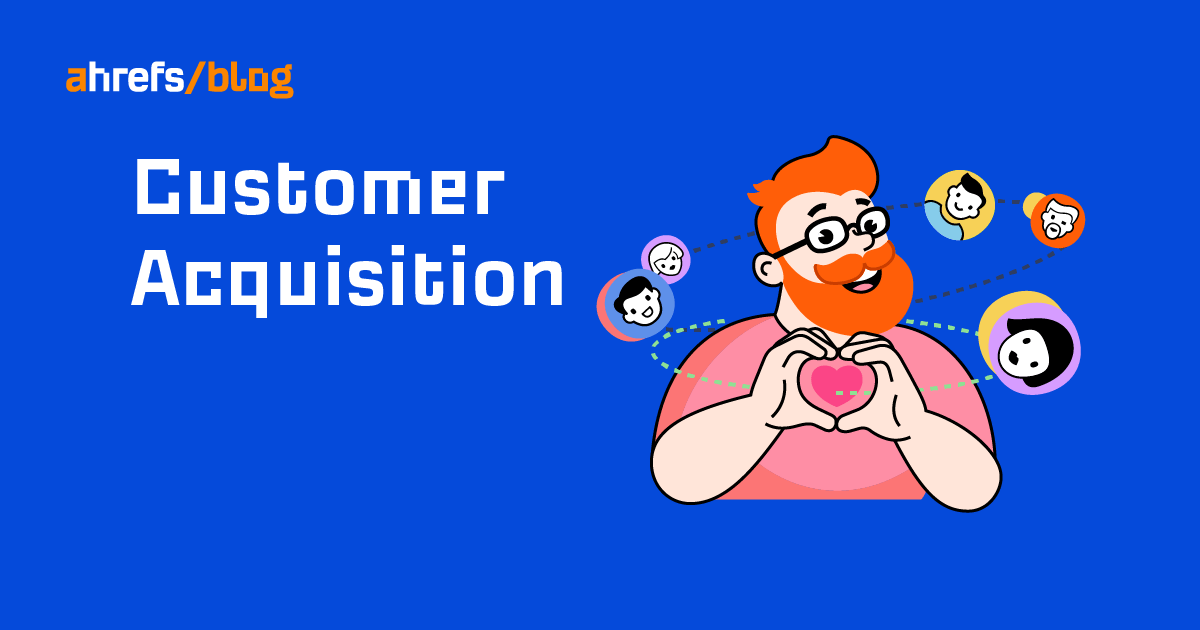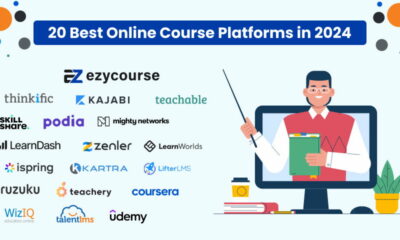SEO
The Essential Guide to Customer Acquisition

Customers are the lifeblood of any business.
Without new customers, businesses cannot survive, let alone grow.
In this guide, you’ll learn how to acquire more new customers for your business.
Here’s what we’ll cover:
Customer acquisition is the process of gaining new customers for a business.
Customer acquisition is not a “one-step” process. Most prospects don’t turn into customers instantly. Instead, they follow a journey:
- Awareness – The buyer realizes they have a problem. They want to understand more about it.
- Consideration – The buyer is looking for and comparing potential solutions to their problem.
- Decision – The buyer purchases a solution.

So, in order to acquire new customers, you need to align your marketing with these three stages.
- Awareness – You need to appear in the consciousness or awareness of your potential customers. You’ll also need to show them your product or service can help to solve their problem.
- Consideration – You need to convince these prospects that they should choose your product or service.
- Decision – You need to “tip” these prospects over the finishing line. Common tactics include discounts and free trials.
Customer acquisition isn’t about executing a variety of tactics and hoping one sticks. You need a strategy, i.e., your battle plan. This is how you’re going to attract new customers and choose the right acquisition tactics.

Here’s how to create a customer acquisition strategy.
1. Identify your customers and where they hang out
If you don’t know who your customers are, you can’t attract more of them to your business.
That’s why the first step of your customer acquisition strategy is to figure out who your ideal customers are.
If you’ve done your market research and created customer personas, then this should be easy. You’ll already know who you’re trying to reach.
For example, here’s a simplified version of our ideal customer at Ahrefs:
SEO professionals and website owners who want to drive more traffic to their websites.
If you’re still in the early stages and don’t have a customer statement like this yet, don’t worry. You can use this guide to create one for your business.
Knowing who your ideal customers are will also help you figure out which marketing channels you should use. For example, we know website owners who desire more traffic are often searching on Google and looking for helpful guides.
This is one of the main reasons why SEO-driven content marketing is our main marketing tactic.
Experienced SEOs tend to hang out a lot on Twitter too, and that’s why we have a heavy presence there.
2. Set your goals
For your strategy to work, you need to know your destination. That is your goal.
Ideally, you should have goals for each stage of the buyer’s journey. But in reality, most companies have limited manpower, time, budget, and resources. So attempting to achieve goals for each stage may prove to be difficult.
In that case, you’ll have to prioritize. I suggest focusing on the area where you’re lacking the most currently.
For example, perhaps you may have a lot of traffic coming to your website (awareness). Yet you aren’t seeing any substantial increase in your sales (purchase). As such, you may want to set a goal and tackle the “problem area.”
Once you’ve identified what you want to work on, you should set a SMART objective to make it clear what it is you want to achieve.
- Specific – It should clearly state the desired outcome.
- Measurable – It should be something you can track the success of.
- Achievable – It should be realistic.
- Relevant – It should align with your overall business objectives.
- Timely – It should have a time frame attached to it.
For example, this is a good objective aligned with the SMART criteria:
Increase the conversion rate of your free trial to a paid subscription from 1% to 3% in the next 12 months.
3. Choose your customer acquisition channels
Based on what you’ve designed so far in your strategy, you should have an idea of which channels may work best to acquire new customers.
Pick one to two of the most suitable ones and begin experimenting with them. (More about the different channels in the next section.)
Here are some of the most popular customer acquisition channels you can experiment with for your business.
1. Search engine optimization (SEO)
SEO is the practice of optimizing a website or webpage to increase the quantity and quality of its traffic from a search engine’s organic results.
Pros
- Passive, organic (almost free) traffic
- Evergreen and compounding effects; article written a few years ago can still generate traffic if it ranks high on the search engines
- Potential customers are automatically qualified by their search intents, e.g., someone searching “ahrefs vs moz” is closer to buying than someone searching “how to increase website traffic”
- SEO content can influence entire marketing funnel
Cons
- Ranking high on search engines takes time
- Popular terms can get competitive (i.e., lots of time and resources required)
- Return on investment (ROI) can be difficult to measure
- Slower effects for newcomers; website with smaller number of high-quality backlinks and low topical authority may find it tougher to rank higher in the beginning stages
2. Content marketing
Content marketing is the process of creating and distributing content to attract and retain customers.
Pros
- Educates potential customers
- Builds loyalty and retention
- Can go viral in the short term and create a lot of attention and awareness at once
- Builds credibility
- Can be the basis of other marketing channels (e.g., digital advertising)
Cons
- ROI can be difficult to measure
- Requires time to work
- Content needs to be promoted and distributed; otherwise, attention may be scarce
- Content must be high quality; otherwise, it can’t stand out from the tons of other published content
3. Digital advertising
Digital advertising is the process of paying a website or platform to reach its audience via ad space.
Pros
- Fast way to get traffic; just set up an ad and get it running in a matter of minutes
- Highly specific targeting (geography, age, gender, interests, etc)
- Easy to measure and scale
Cons
- Can be expensive (especially when scaling up)
- Learning curve exists; costs time and money to figure out what works for your exact business
- Suffers from symptoms like ad fatigue and banner blindness
- Increasing use of ad blockers and third-party cookies blocking by web browsers may affect measurement and effectiveness
4. Influencer marketing
Influencer marketing is the practice of working with influencers—people who have an active, sizable audience—to promote your brand’s message, products, or services.
Pros
- Good way to improve brand awareness
- Popular influencers can “bestow” a halo effect on your brand
- Can generate direct sales, e.g., via influencer-specific discount codes
Cons
- ROI can be difficult to measure
- No guaranteed returns when working with influencers
- Risk of unwanted brand associations if you work with the wrong person
- Limited control over creative or messaging
5. Email marketing
Email marketing lets you reach your prospects’ mailboxes with messages that either prompt direct action or aim to encourage prospects to create a long-term relationship with the brand.
Pros
- Easily reach your prospects or customers directly (and at any time)
- Emails sent can be highly personalized and segmented
- Easy to measure
Cons
- Takes time to organically build a quality email list
- Overdoing it can cause you to break email marketing legislation (GDPR, CAN-SPAM, etc)
- Can be competitive (people’s inboxes are flooded with emails!)
6. Video marketing
Video marketing is the process of creating and distributing video content to attract and retain customers.
Pros
- Great for demonstrating how a product works
- Can be later repurposed into other content formats (e.g., your script can be turned into a blog post; main video can be turned into multiple, bite-sized versions)
- Engaging videos can capture and retain attention much more effectively than other formats
Cons
- Very resource-intensive to produce one high-quality video, let alone many
7. Social media
Social media drives traffic to your webpages and creates engagement with your brand by means of social media platforms.
Pros
- Organic, almost free traffic
- Massive audiences can be found on different social media platforms
- Can interact directly with your audience
Cons
- Not easy to build a following on social media
- Social media platforms may decrease your organic reach (to get more people to pay for ads)
- May be at “mercy” of these platforms; you can get banned or removed anytime, which means losing all your following
- May experience many negative comments and trolls
8. Referral programs
A referral program incentivizes existing customers to promote your brand to their family and friends.
Pros
- Can be a low-cost way to acquire new customers
- Builds customer loyalty
Cons
- No guarantees that a referral program will work
- Can’t “force” your customers to refer their friends
Here are some examples of how different businesses have acquired their customers.
1. Ahrefs – Content marketing
Ahrefs is an all-in-one SEO toolset that allows you to do keyword research, competitor analysis, website audits, content research, rank tracking, and more.
The main customer acquisition strategy we use at Ahrefs is SEO-driven content marketing. Here’s how we do it:
First, we find topics that our target customers are searching for on Google.
As mentioned earlier, our customers are often searching on Google for solutions to their problems. This makes SEO an ideal acquisition channel. Ranking high on Google also ensures that we get passive, organic traffic, as long as our content stays on top.

How do we find these topics?
- Go to Ahrefs’ Keywords Explorer
- Enter one or a few relevant keywords
- Go to the Matching terms report
- Switch to Questions

As you can see, there are over 180,000 topics to choose from. We’ll eyeball the list and note down those that are relevant to our customers.
Once we have a list of topics, we decide which topics to target first using business potential.

We start with topics that have a score of “3,” then “2,” and so on.
With a list of topics to work on, we create content based on this framework:
2. Circles.Life – Referral program
Circles.Life is a digital telco based in Singapore. Despite entrenched competition from the three existing major telcos in Singapore, Circles.Life has managed to succeed. (I, too, am one of its customers.)
One of the main ways it acquired its customers (at least in the early days) was via its referral program. In fact, according to HireDigital, over 40% of Circles.Life transactions come from referrals.

The success of a referral program depends on a few factors, but the main one is the incentive. An attractive incentive motivates customers to share; a bad one drives no action.
In this case, Circles.Life’s referral program succeeded because the prize was exactly what telco customers wanted: more data for low prices.
This is reminiscent of Dropbox’s referral program, which was also one of the main ways the cloud storage company acquired its first customers.
Recommended reading: How to Choose the Right Referral Incentives for Your Referral Program (With 20+ Examples!)
3. Luxy Hair – Video marketing
Luxy Hair is an online store that sells hair extensions and hair-related accessories. With over 3 million subscribers on YouTube, it’s killing it.

Luxy Hair makes videos that get thousands, if not millions, of views.

Each video features different ways of styling hair, taking care of it, and more. And each video—ding ding ding, you guessed it—features Luxy Hair’s own products.
The company then makes it easy for any viewer or subscriber to buy by including the relevant links in the video description.

Recommended reading: The Four-Part Formula That Got Luxy Hair 2.8 Million Subscribers on YouTube
Here are some frequently asked questions related to customer acquisition.
How do you calculate customer acquisition cost?
Customer acquisition cost (CAC) is the average amount of money you spend to acquire a single customer.
This is calculated by dividing your customer acquisition expenses by the number of acquired customers.
CAC = Total amount spent on marketing/Number of new customers acquired
For example, if you acquired 10 new customers after spending $1,000 on your marketing, your CAC would be $1000/10 = $100.
What is the average customer acquisition cost?
According to Shopify’s research, here are the average CACs by industry:
- Arts and entertainment: $21
- Business and industrial: $533
- Clothing, shoes, and/or accessories: $129
- Electronics and/or electronics accessories: $377
- Food, beverages, and tobacco products: $462
- Health and beauty: $127
- Home and garden: $129
Don’t take these benchmarks as gospel. These numbers are averages and can differ depending on your brand, exact market, average order value, and more. You should always relate your CAC to your own business.
Why is customer acquisition cost important?
Many businesses calculate the CAC because they want to lower it.
However, trying to reduce your CAC in isolation is not a good idea. Most of the time, reducing your CAC and being more effective in marketing don’t necessarily go hand in hand.
If your CAC is too low, you may actually be limiting your exposure and under-spending on your marketing activities. Your balance sheet may look good in the short term, but you may be missing out on substantial growth opportunities in the long term.
So, rather than strive to pay as little as possible, aim for marketing effectiveness.
To do this, you should use CAC in relation to your customer lifetime value (CLV). This is a metric that estimates how much money an individual customer will spend on your products or services.
Here’s how CLV is calculated:
Avg. order value x Avg. annual purchase frequency x Avg. customer lifespan
Take this into account, alongside your customer base growth and overall marketing effectiveness, when deciding if you should adjust your CAC.
Recommended reading: How to Use & Reduce Customer Acquisition Cost (CAC)
What is customer retention?
Customer retention happens after a customer is acquired. The goal of customer retention is to keep your customers with your brand for a long time.
This is because a loyal customer is more valuable to a business. Not only will they buy more (and buy more frequently), but new customers are also often more expensive to acquire.
Customer acquisition and customer retention are not mutually exclusive. Both are important to a business’s growth and survival and should exist at the same time.
Some marketers even argue that customer retention should actually take precedence over customer acquisition—after all, there’s no point filling a leaky bucket.
7. Focus on retention first, not acquisition.
Retention drives acquisition.
Retention gives you a competitive edge > Retention drives referral > referral drives word of mouth > word of mouth is a powerful acquisition channel.
Retention gives you MOAT to acquire more customers.
— Aazar Shad (@Aazarshad) July 12, 2021
Recommended reading: What Is Customer Retention? 11 Examples and Strategies to Retain Customers
How do you measure customer acquisition?
Besides CAC and CLV, which metrics should you measure?
This depends on the exact tactic you’re using. I recommend reading the guide below for a sample of the most important customer acquisition metrics you should be tracking.
Recommended reading: 25 Marketing Metrics You Should Consider Tracking
Final thoughts
If you want to acquire new customers on a consistent basis, you need a strategy. Create one and then execute only the tactics that move your business ahead.
Did I miss out on anything important about customer acquisition? Let me know on Twitter.
SEO
How to Revive an Old Blog Article for SEO

Quick question: What do you typically do with your old blog posts? Most likely, the answer is: Not much.
If that’s the case, you’re not alone. Many of us in SEO and content marketing tend to focus on continuously creating new content, rather than leveraging our existing blog posts.
However, here’s the reality—Google is becoming increasingly sophisticated in evaluating content quality, and we need to adapt accordingly. Just as it’s easier to encourage existing customers to make repeat purchases, updating old content on your website is a more efficient and sustainable strategy in the long run.
Ways to Optimize Older Content
Some of your old content might not be optimized for SEO very well, rank for irrelevant keywords, or drive no traffic at all. If the quality is still decent, however, you should be able to optimize it properly with little effort.
Refresh Content
If your blog post contains a specific year or mentions current events, it may become outdated over time. If the rest of the content is still relevant (like if it’s targeting an evergreen topic), simply updating the date might be all you need to do.
Rewrite Old Blog Posts
When the content quality is low (you might have greatly improved your writing skills since you’ve written the post) but the potential is still there, there’s not much you can do apart from rewriting an old blog post completely.
This is not a waste—you’re saving time on brainstorming since the basic structure is already in place. Now, focus on improving the quality.
Delete Old Blog Posts
You might find a blog post that just seems unusable. Should you delete your old content? It depends. If it’s completely outdated, of low quality, and irrelevant to any valuable keywords for your website, it’s better to remove it.
Once you decide to delete the post, don’t forget to set up a 301 redirect to a related post or page, or to your homepage.
Promote Old Blog Posts
Sometimes all your content needs is a bit of promotion to start ranking and getting traffic again. Share it on your social media, link to it from a new post – do something to get it discoverable again to your audience. This can give it the boost it needs to attract organic links too.
Which Blog Posts Should You Update?
Deciding when to update or rewrite blog posts is a decision that relies on one important thing: a content audit.
Use your Google Analytics to find out which blog posts used to drive tons of traffic, but no longer have the same reach. You can also use Google Search Console to find out which of your blog posts have lost visibility in comparison to previous months. I have a guide on website analysis using Google Analytics and Google Search Console you can follow.
If you use keyword tracking tools like SE Ranking, you can also use the data it provides to come up with a list of blog posts that have dropped in the rankings.
Make data-driven decisions to identify which blog posts would benefit from these updates – i.e., which ones still have the chance to recover their keyword rankings and organic traffic.
With Google’s helpful content update, which emphasizes better user experiences, it’s crucial to ensure your content remains relevant, valuable, and up-to-date.
How To Update Old Blog Posts for SEO
Updating articles can be an involved process. Here are some tips and tactics to help you get it right.
Author’s Note: I have a Comprehensive On-Page SEO Checklist you might also be interested in following while you’re doing your content audit.
Conduct New Keyword Research
Updating your post without any guide won’t get you far. Always do your keyword research to understand how users are searching for your given topic.
Proper research can also show you relevant questions and sections that can be added to the blog post you’re updating or rewriting. Make sure to take a look at the People Also Ask (PAA) section that shows up when you search for your target keyword. Check out other websites like Answer The Public, Reddit, and Quora to see what users are looking for too.
Look for New Ranking Opportunities
When trying to revive an old blog post for SEO, keep an eye out for new SEO opportunities (e.g., AI Overview, featured snippets, and related search terms) that didn’t exist when you first wrote your blog post. Some of these features can be targeted by the new content you will add to your post, if you write with the aim to be eligible for it.
Rewrite Headlines and Meta Tags
If you want to attract new readers, consider updating your headlines and meta tags.
Your headlines and meta tags should fulfill these three things:
- Reflect the rewritten and new content you’ve added to the blog post.
- Be optimized for the new keywords it’s targeting (if any).
- Appeal to your target audience – who may have changed tastes from when the blog post was originally made.
Remember that your meta tags in particular act like a brief advertisement for your blog post, since this is what the user first sees when your blog post is shown in the search results page.
Take a look at your blog post’s click-through rate on Google Search Console – if it falls below 2%, it’s definitely time for new meta tags.
Replace Outdated Information and Statistics
Updating blog content with current studies and statistics enhances the relevance and credibility of your post. By providing up-to-date information, you help your audience make better, well-informed decisions, while also showing that your content is trustworthy.
Tighten or Expand Ideas
Your old content might be too short to provide real value to users – or you might have rambled on and on in your post. It’s important to evaluate whether you need to make your content more concise, or if you need to elaborate more.
Keep the following tips in mind as you refine your blog post’s ideas:
- Evaluate Helpfulness: Measure how well your content addresses your readers’ pain points. Aim to follow the E-E-A-T model (Experience, Expertise, Authoritativeness, Trustworthiness).
- Identify Missing Context: Consider whether your content needs more detail or clarification. View it from your audience’s perspective and ask if the information is complete, or if more information is needed.
- Interview Experts: Speak with industry experts or thought leaders to get fresh insights. This will help support your writing, and provide unique points that enhance the value of your content.
- Use Better Examples: Examples help simplify complex concepts. Add new examples or improve existing ones to strengthen your points.
- Add New Sections if Needed: If your content lacks depth or misses a key point, add new sections to cover these areas more thoroughly.
- Remove Fluff: Every sentence should contribute to the overall narrative. Eliminate unnecessary content to make your post more concise.
- Revise Listicles: Update listicle items based on SEO recommendations and content quality. Add or remove headings to stay competitive with higher-ranking posts.
Improve Visuals and Other Media
No doubt that there are tons of old graphics and photos in your blog posts that can be improved with the tools we have today. Make sure all of the visuals used in your content are appealing and high quality.
Update Internal and External Links
Are your internal and external links up to date? They need to be for your SEO and user experience. Outdated links can lead to broken pages or irrelevant content, frustrating readers and hurting your site’s performance.
You need to check for any broken links on your old blog posts, and update them ASAP. Updating your old blog posts can also lead to new opportunities to link internally to other blog posts and pages, which may not have been available when the post was originally published.
Optimize for Conversions
When updating content, the ultimate goal is often to increase conversions. However, your conversion goals may have changed over the years.
So here’s what you need to check in your updated blog post. First, does the call-to-action (CTA) still link to the products or services you want to promote? If not, update it to direct readers to the current solution or offer.
Second, consider where you can use different conversion strategies. Don’t just add a CTA at the end of the post.
Last, make sure that the blog post leverages product-led content. It’s going to help you mention your products and services in a way that feels natural, without being too pushy. Being subtle can be a high ROI tactic for updated posts.
Key Takeaway
Reviving old blog articles for SEO is a powerful strategy that can breathe new life into your content and boost your website’s visibility. Instead of solely focusing on creating new posts, taking the time to refresh existing content can yield impressive results, both in terms of traffic and conversions.
By implementing these strategies, you can transform old blog posts into valuable resources that attract new readers and retain existing ones. So, roll up your sleeves, dive into your archives, and start updating your content today—your audience and search rankings will thank you!
SEO
How Compression Can Be Used To Detect Low Quality Pages

The concept of Compressibility as a quality signal is not widely known, but SEOs should be aware of it. Search engines can use web page compressibility to identify duplicate pages, doorway pages with similar content, and pages with repetitive keywords, making it useful knowledge for SEO.
Although the following research paper demonstrates a successful use of on-page features for detecting spam, the deliberate lack of transparency by search engines makes it difficult to say with certainty if search engines are applying this or similar techniques.
What Is Compressibility?
In computing, compressibility refers to how much a file (data) can be reduced in size while retaining essential information, typically to maximize storage space or to allow more data to be transmitted over the Internet.
TL/DR Of Compression
Compression replaces repeated words and phrases with shorter references, reducing the file size by significant margins. Search engines typically compress indexed web pages to maximize storage space, reduce bandwidth, and improve retrieval speed, among other reasons.
This is a simplified explanation of how compression works:
- Identify Patterns:
A compression algorithm scans the text to find repeated words, patterns and phrases - Shorter Codes Take Up Less Space:
The codes and symbols use less storage space then the original words and phrases, which results in a smaller file size. - Shorter References Use Less Bits:
The “code” that essentially symbolizes the replaced words and phrases uses less data than the originals.
A bonus effect of using compression is that it can also be used to identify duplicate pages, doorway pages with similar content, and pages with repetitive keywords.
Research Paper About Detecting Spam
This research paper is significant because it was authored by distinguished computer scientists known for breakthroughs in AI, distributed computing, information retrieval, and other fields.
Marc Najork
One of the co-authors of the research paper is Marc Najork, a prominent research scientist who currently holds the title of Distinguished Research Scientist at Google DeepMind. He’s a co-author of the papers for TW-BERT, has contributed research for increasing the accuracy of using implicit user feedback like clicks, and worked on creating improved AI-based information retrieval (DSI++: Updating Transformer Memory with New Documents), among many other major breakthroughs in information retrieval.
Dennis Fetterly
Another of the co-authors is Dennis Fetterly, currently a software engineer at Google. He is listed as a co-inventor in a patent for a ranking algorithm that uses links, and is known for his research in distributed computing and information retrieval.
Those are just two of the distinguished researchers listed as co-authors of the 2006 Microsoft research paper about identifying spam through on-page content features. Among the several on-page content features the research paper analyzes is compressibility, which they discovered can be used as a classifier for indicating that a web page is spammy.
Detecting Spam Web Pages Through Content Analysis
Although the research paper was authored in 2006, its findings remain relevant to today.
Then, as now, people attempted to rank hundreds or thousands of location-based web pages that were essentially duplicate content aside from city, region, or state names. Then, as now, SEOs often created web pages for search engines by excessively repeating keywords within titles, meta descriptions, headings, internal anchor text, and within the content to improve rankings.
Section 4.6 of the research paper explains:
“Some search engines give higher weight to pages containing the query keywords several times. For example, for a given query term, a page that contains it ten times may be higher ranked than a page that contains it only once. To take advantage of such engines, some spam pages replicate their content several times in an attempt to rank higher.”
The research paper explains that search engines compress web pages and use the compressed version to reference the original web page. They note that excessive amounts of redundant words results in a higher level of compressibility. So they set about testing if there’s a correlation between a high level of compressibility and spam.
They write:
“Our approach in this section to locating redundant content within a page is to compress the page; to save space and disk time, search engines often compress web pages after indexing them, but before adding them to a page cache.
…We measure the redundancy of web pages by the compression ratio, the size of the uncompressed page divided by the size of the compressed page. We used GZIP …to compress pages, a fast and effective compression algorithm.”
High Compressibility Correlates To Spam
The results of the research showed that web pages with at least a compression ratio of 4.0 tended to be low quality web pages, spam. However, the highest rates of compressibility became less consistent because there were fewer data points, making it harder to interpret.
Figure 9: Prevalence of spam relative to compressibility of page.
The researchers concluded:
“70% of all sampled pages with a compression ratio of at least 4.0 were judged to be spam.”
But they also discovered that using the compression ratio by itself still resulted in false positives, where non-spam pages were incorrectly identified as spam:
“The compression ratio heuristic described in Section 4.6 fared best, correctly identifying 660 (27.9%) of the spam pages in our collection, while misidentifying 2, 068 (12.0%) of all judged pages.
Using all of the aforementioned features, the classification accuracy after the ten-fold cross validation process is encouraging:
95.4% of our judged pages were classified correctly, while 4.6% were classified incorrectly.
More specifically, for the spam class 1, 940 out of the 2, 364 pages, were classified correctly. For the non-spam class, 14, 440 out of the 14,804 pages were classified correctly. Consequently, 788 pages were classified incorrectly.”
The next section describes an interesting discovery about how to increase the accuracy of using on-page signals for identifying spam.
Insight Into Quality Rankings
The research paper examined multiple on-page signals, including compressibility. They discovered that each individual signal (classifier) was able to find some spam but that relying on any one signal on its own resulted in flagging non-spam pages for spam, which are commonly referred to as false positive.
The researchers made an important discovery that everyone interested in SEO should know, which is that using multiple classifiers increased the accuracy of detecting spam and decreased the likelihood of false positives. Just as important, the compressibility signal only identifies one kind of spam but not the full range of spam.
The takeaway is that compressibility is a good way to identify one kind of spam but there are other kinds of spam that aren’t caught with this one signal. Other kinds of spam were not caught with the compressibility signal.
This is the part that every SEO and publisher should be aware of:
“In the previous section, we presented a number of heuristics for assaying spam web pages. That is, we measured several characteristics of web pages, and found ranges of those characteristics which correlated with a page being spam. Nevertheless, when used individually, no technique uncovers most of the spam in our data set without flagging many non-spam pages as spam.
For example, considering the compression ratio heuristic described in Section 4.6, one of our most promising methods, the average probability of spam for ratios of 4.2 and higher is 72%. But only about 1.5% of all pages fall in this range. This number is far below the 13.8% of spam pages that we identified in our data set.”
So, even though compressibility was one of the better signals for identifying spam, it still was unable to uncover the full range of spam within the dataset the researchers used to test the signals.
Combining Multiple Signals
The above results indicated that individual signals of low quality are less accurate. So they tested using multiple signals. What they discovered was that combining multiple on-page signals for detecting spam resulted in a better accuracy rate with less pages misclassified as spam.
The researchers explained that they tested the use of multiple signals:
“One way of combining our heuristic methods is to view the spam detection problem as a classification problem. In this case, we want to create a classification model (or classifier) which, given a web page, will use the page’s features jointly in order to (correctly, we hope) classify it in one of two classes: spam and non-spam.”
These are their conclusions about using multiple signals:
“We have studied various aspects of content-based spam on the web using a real-world data set from the MSNSearch crawler. We have presented a number of heuristic methods for detecting content based spam. Some of our spam detection methods are more effective than others, however when used in isolation our methods may not identify all of the spam pages. For this reason, we combined our spam-detection methods to create a highly accurate C4.5 classifier. Our classifier can correctly identify 86.2% of all spam pages, while flagging very few legitimate pages as spam.”
Key Insight:
Misidentifying “very few legitimate pages as spam” was a significant breakthrough. The important insight that everyone involved with SEO should take away from this is that one signal by itself can result in false positives. Using multiple signals increases the accuracy.
What this means is that SEO tests of isolated ranking or quality signals will not yield reliable results that can be trusted for making strategy or business decisions.
Takeaways
We don’t know for certain if compressibility is used at the search engines but it’s an easy to use signal that combined with others could be used to catch simple kinds of spam like thousands of city name doorway pages with similar content. Yet even if the search engines don’t use this signal, it does show how easy it is to catch that kind of search engine manipulation and that it’s something search engines are well able to handle today.
Here are the key points of this article to keep in mind:
- Doorway pages with duplicate content is easy to catch because they compress at a higher ratio than normal web pages.
- Groups of web pages with a compression ratio above 4.0 were predominantly spam.
- Negative quality signals used by themselves to catch spam can lead to false positives.
- In this particular test, they discovered that on-page negative quality signals only catch specific types of spam.
- When used alone, the compressibility signal only catches redundancy-type spam, fails to detect other forms of spam, and leads to false positives.
- Combing quality signals improves spam detection accuracy and reduces false positives.
- Search engines today have a higher accuracy of spam detection with the use of AI like Spam Brain.
Read the research paper, which is linked from the Google Scholar page of Marc Najork:
Detecting spam web pages through content analysis
Featured Image by Shutterstock/pathdoc
SEO
New Google Trends SEO Documentation

Google Search Central published new documentation on Google Trends, explaining how to use it for search marketing. This guide serves as an easy to understand introduction for newcomers and a helpful refresher for experienced search marketers and publishers.
The new guide has six sections:
- About Google Trends
- Tutorial on monitoring trends
- How to do keyword research with the tool
- How to prioritize content with Trends data
- How to use Google Trends for competitor research
- How to use Google Trends for analyzing brand awareness and sentiment
The section about monitoring trends advises there are two kinds of rising trends, general and specific trends, which can be useful for developing content to publish on a site.
Using the Explore tool, you can leave the search box empty and view the current rising trends worldwide or use a drop down menu to focus on trends in a specific country. Users can further filter rising trends by time periods, categories and the type of search. The results show rising trends by topic and by keywords.
To search for specific trends users just need to enter the specific queries and then filter them by country, time, categories and type of search.
The section called Content Calendar describes how to use Google Trends to understand which content topics to prioritize.
Google explains:
“Google Trends can be helpful not only to get ideas on what to write, but also to prioritize when to publish it. To help you better prioritize which topics to focus on, try to find seasonal trends in the data. With that information, you can plan ahead to have high quality content available on your site a little before people are searching for it, so that when they do, your content is ready for them.”
Read the new Google Trends documentation:
Get started with Google Trends
Featured Image by Shutterstock/Luis Molinero












You must be logged in to post a comment Login